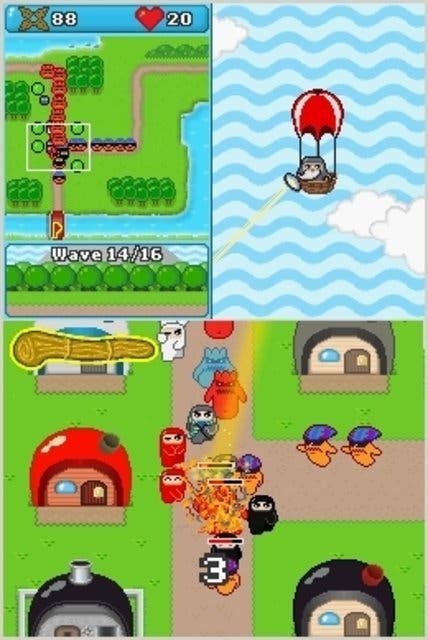Ninjatown
Not as safe a place as you might think.
Ninjatown is a very silly game. You play an ancient ninja master directing his chibi-ninja disciples in an effort to stop Mr Demon from stealing an ancient ninja recipe for sugar-cookies. It's bright and cute and full of silly LOL NINJAS jokes about ninja droppings and moustaches and tie-wearing business ninjas who worry about their sugar stock. No mention of pirates, though, which is odd for a game that tries to squeeze as much cheesy jocularity as it possibly can into every line of dialogue or tutorial.
But Ninjatown hides an interesting, tough strategic core underneath all the sugary frivolity. It plays like a fast-paced PixelJunk Monsters with a broader array of units and maps, as waves of little demons make their way from one end of the map to the other while you place ninja houses and a gradually broadening array of support units to stop them. It's about balancing your available resources as well as placing your Wee Ninjas cleverly, learning when to spend your money on upgrading houses and when to keep building until the map is a busy jumble of demon face-punching.
The game eases you in for a good four or five levels, introducing the basic ninja and demon types and letting you experiment, but the pace soon quickens as new ninja types and special powers are introduced and the incoming enemies become stronger and faster, and it's necessary to dash frantically around the map micromanaging battles. Soon it's nearly impossible to beat a level on the first try. Ninjatown relies on a fair amount of trial and error; the map shows you which type of demon is on its way and where the next wave will appear, but there's no way to gain an impression of the overall flow of a level except to fail it a few times and learn from your mistakes.

To some extent that's the nature of the puzzle-strategy beast, and Ninjatown minimises the frustration by limiting the majority of its battles to ten minutes or so. There's always a chance to do things differently, too - try out a completely new array of units, or throw down a special Ninja Power. You're also involved enough in the battles to feel constantly occupied; rather than leaving you to sit back and watch your strategy play out, you're running around upgrading or building dojos or poking a slovenly ninja in the belly to give him a little speed boost. As a result, the inevitable repetition is rarely tedious.
The game's light-hearted tone also saves you becoming too frustrated, because it's hard to stay angry at something so unapologetically silly. The dialogue comes across as hammy and over-thought from time to time, but you still crack a smile, and the cutesy art style strikes the right balance between saccharine and funny. When Ninjatown's tone hits the mark, it's genuinely lovable. It also gets bonus internet points for incorporating a smattering of memes ("How many enemies? Why, it's got to be over 9,000!") without slipping into glaring non-sequiturs.
But what keeps you addicted to Ninjatown is the slow drip-feed of new units, which continues all the way through the game. At first the selection is restricted to basic Wee Ninjas and slower, more powerful Anti-Ninjas, but this broadens over the first fifteen or twenty levels to include enemy-freezing Snow Ninjas, long-range Sniper Ninjas, Lava Ninjas, tie-adorned and enemy-distracting Business Ninjas, and the slightly racist, scooter-riding Italian Wee Ninjas, amongst others.

The Ninja Power gimmicks are fun and appropriately silly ways to gain the edge in the middle of a level. One of them has you shouting words of encouragement into the microphone to boost ninja morale, sending them into speed and power overdrive. Another has you blowing to send escaping enemies billowing back up the screen towards your defences. It's dumb, but in an enjoyable way, and the Ninja Powers are considered; the ability to buy extra time or power up ninjas during an intensive assault develops from desperate last resort to a strategic necessity as the game progresses.
Elsewhere, Ninjatown's multiplayer mode is ferociously competitive, and works perfectly well with just one cartridge on three of the nine maps. It's a race to see who can eliminate all the enemies first, and it's quite a different beast from the single-player, focusing your attention on movement and reflexes rather than strategy and long-term plans. Given that Ninjatown is easy to learn, it's easy to rope people in for a game or two, which quickly becomes three or four. Playing in multiplayer highlights many of the things that make Ninjatown such a good handheld game; it's fast, accessible and equally easy to play for ten minutes or two hours.
At PixelJunk Monsters' price-point, Ninjatown would be an essential purchase, but as a full-price DS release it stops slightly short. That said, it's still a likeable, accessible and deceptively complex little strategy game, worth 20-odd quid of any pocket strategist's money, and it keeps on giving, feeding you something new and fun to play with right up until the fist-eatingly difficult last few levels. We'll forgive its incessant wisecracking for that. And then hug it.

